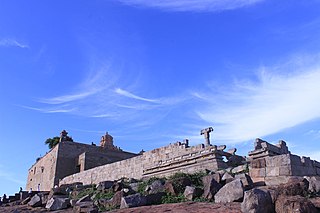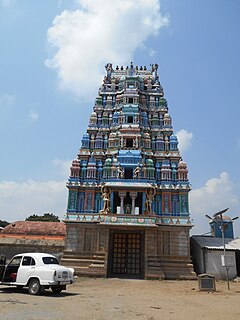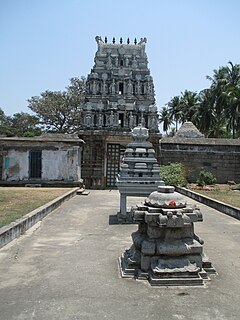
Erumbeeswarar Temple in Thiruverumbur, Tamil Nadu, India, is a Hindu temple dedicated to the deity Shiva. Built on a 60-foot (18 m) tall hill, it is accessible via a flight of steps. The temple's main shrines and its two prakarams are on top of the hill, while a hall and the temple tank are located at the foothills. Shiva is believed to have transformed himself into an ant hill and tilted his head at this place to enable ants to climb up and worship him. Erumbeeswarar is revered in the canonical 7th-century Tamil Saiva work the Tevaram, written by Tamil saint poets known as nayanmars and classified as Paadal Petra Sthalam.

Thiruvathigai Veerateeswarar Temple is a Hindu temple dedicated to Shiva. It is situated in Thiruvathigai village which is about 2 kilometres east from the town of Panruti in the South Indian state of Tamil Nadu, India. Shiva is worshiped as Veerattaaneswarar, and is represented by the lingam. His consort Parvati is depicted as Thiripurasundari. The presiding deity is revered in the 7th century Tamil Saiva canonical work, the Tevaram, written by Tamil saint poets known as the nayanars and classified as Paadal Petra Sthalam. The temple is considered the place where the Saiva saint poet Appar (Thirunavukkarasar) converted back to Saivism, and attained final salvation.

Neyyadiappar Temple, Tillaistanam is a Hindu temple dedicated to Shiva located in the village of Thillaistanam also known as Tillaistanam or Thiruneithanam in Tamil Nadu, India. It is significant to the Hindu sect of Saivism as one of the Sapthastanam, the seven temples associated with Aiyarappar temple in Thiruvaiyaru. Shiva is represented by the lingam in the form of Neyyadiappar. His consort Parvati is depicted as Piraisoodi Amman. The presiding deity is revered in the 7th century Tamil Saiva canonical work, the Tevaram, written by Tamil saint poets known as the nayanars and classified as Paadal Petra Sthalam.

Padikasu Nathar Temple is a Hindu temple located at Azhagaputhur, a village in the Thanjavur district of Tamil Nadu, India. Shiva is worshiped as Padikasunathar, and is represented by the lingam. His consort Parvati is depicted as Soundaranayagi. The presiding deity is revered in the 7th century Tamil Saiva canonical work, the Tevaram, written by Tamil saint poets known as the nayanars and classified as Paadal Petra Sthalam. The 8th century Saiva saint poet Sundarar has sung praise about the temple in his works.

Panchavarnaswamy Temple is a Hindu temple dedicated to Shiva, located in Woraiyur, a suburb in the town of Tiruchirapalli in Tamil Nadu, India. Shiva is believed to portray five different colours, giving the name of the presiding deity, Panchavarnaswamy. Panchavarnaswamy is revered in the 7th century Tamil Saiva canonical work, the Tevaram, written by Tamil saint poets known as the nayanars and classified as Paadal Petra Sthalam.

Kuzhagar Temple or Kodi Kuzhagar Temple is a Hindu temple dedicated to Shiva, located in the town of Kodikkarai in Tamil Nadu, India. Kuzhagar is revered in the 7th century Tamil Saiva canonical work, the Tevaram, written by Tamil saint poets known as the nayanars and classified as Paadal Petra Sthalam.

Agastheeswarar Temple is a Hindu temple dedicated to Shiva, located in the town of Agathiyampalli, Nagapattinam district in Tamil Nadu, India. The presiding deity is revered in the seventh century Tamil Saiva canonical work, the Tevaram, written by Tamil saint poets known as the nayanmars and classified as Paadal Petra Sthalam. The temple is locally called Agasthiyar Kovil.

Chandramowleeswarar Temple, Thiruvakkarai in Thiruvakkarai, a village in Villupuram district in the South Indian state of Tamil Nadu, is dedicated to the Hindu god Shiva. Constructed in the Dravidian style of architecture, the temple is believed to have been built during the Cholas period in the 10th century. The temple has received gracious endowments from the Chola queen Sembiyan Mahadevi. Shiva is worshipped as Chandramowleeswarar and his consort Parvathi as Amirthambigai.

Anekadhangavadeswarar Temple is a Hindu temple dedicated to Shiva, located in the town of Kanchipuram, near Kailasanathar temple, Kanchipuram district in Tamil Nadu, India. Anekadhangavadeswarar is revered in the 7th century Tamil Saiva canonical work, the Tevaram, written by Tamil saint poets known as the nayanars and classified as Paadal Petra Sthalam, the 275 temples reverred in the canon.

Kripapureeswarar Temple in Thiruvennainallur, a panchayat town in Villupuram district in the South Indian state of Tamil Nadu, is dedicated to the Hindu god Shiva. The presiding deity is revered in the 7th century Tamil Saiva canonical work, the Tevaram, written by Tamil saint poets known as the Nayanmars and classified as Paadal Petra Sthalam. The temple is closely associated with Sundarar, the saivite saint of the 8th century, who started composing his Tirumurai starting with "Pitha Piraisudi" verse in this temple.

Thirumuruganatheeswarar Temple in Thirumuruganpoondi, a panchayat town in Tiruppur district in the South Indian state of Tamil Nadu, is dedicated to the Hindu god Shiva. Constructed in the Dravidian style of architecture, the present structure of the temple is believed to have been built during the Kongu Cholas period in the 10th century. Shiva is worshipped as Thirumuruganatheeswarar and his consort Parvathi as Avudainayagi.

Kachabeswarar Temple, Thirukachur is a Hindu temple dedicated to the deity Shiva, located in Thirukachur, a village in Kanchipuram district in the South Indian state of Tamil Nadu. Shiva is worshipped as Kachabeswarar, and is represented by the lingam. His consort Parvati is depicted as Antanatchi and Kanniyumaiyal. The presiding deity is revered in the 7th century Tamil Saiva canonical work, the Tevaram, written by Tamil saint poets known as the Nayanars and classified as Paadal Petra Sthalam. The temple is counted as a twin temple along with Marundeeswarar Temple located in the same village.

Marundeeswarar Temple is a Hindu temple dedicated to the deity Shiva, located in T. Edaiyar, a village in Viluppuram district in the South Indian state of Tamil Nadu. Shiva is worshipped as Marundeeswarar, and is represented by the lingam. His consort Parvati is depicted as Balambigai. The temple is located on the Southern banks of Thenpennai River on the Thirukoilur - Thiruvennainallur road. The presiding deity is revered in the 7th century Tamil Saiva canonical work, the Tevaram, written by Tamil saint poets known as the nayanmars and classified as Paadal Petra Sthalam.

Vaseeswarar Temple is a Hindu temple dedicated to the deity Shiva, located in Thirupasoor, a village in Tiruvallur district in the South Indian state of Tamil Nadu. Shiva is worshiped as Vaseeswarar, and is represented by the lingam. His consort Parvati is depicted as Pasupathinayagi. The temple is located on the Southern banks of Poondi reservoir on the Thiruvallur - Thiruthani road, 5 km (3.1 mi) away from the town. The presiding deity is revered in the 7th century Tamil Saiva canonical work, the Tevaram, written by Tamil saint poets known as the nayanmars and classified as Paadal Petra Sthalam.

Agnipureeswarar Temple in Thirupugalur, a village in Nagapattinam district in the South Indian state of Tamil Nadu, is dedicated to the Hindu god Shiva. Constructed in the Tamil style of architecture, the temple is believed to have been built during the Cholas period in the 10th century. Shiva is worshipped as Agnipureeswarar and his consort Parvathi as Karundar Kuzhali. The temple is believed to be the place where Saiva saint Appar is believed to have attained salvation.

Oondreswarar Temple is a Hindu temple dedicated to the deity Shiva, located in Poondi, a village in Tiruvallur district in the South Indian state of Tamil Nadu. Shiva is worshiped as Oondreswarar, and is represented by the lingam. His consort Parvati is depicted as Minnoli Amman. The temple is located on the Northern banks of Poondi reservoir on the Thiruvallur - Thiruthani road, 11 km (6.8 mi) away from the town. The presiding deity is revered in the 7th century Tamil Saiva canonical work, the Tevaram, written by Tamil saint poets known as the Nayanmars and classified as Paadal Petra Sthalam.

Vamaneeswarar Temple is a Hindu temple dedicated to the deity Shiva, located in Thirumanikuzhi, a village in Cuddalore district in the South Indian state of Tamil Nadu. Shiva is worshiped as Vamaneeswarar, and is represented by the lingam. His consort Parvati is depicted as Manonmani Amman. The temple is located on the Chennai - Villupuram highway on the banks of Kedilam river. The presiding deity is revered in the 7th century Tamil Saiva canonical work, the Tevaram, written by Tamil saint poets known as the nayanmars and classified as Paadal Petra Sthalam.

Sivalokanathar temple is a Hindu temple dedicated to the deity Shiva, located in Gramam, a village in Villupuram district in the South Indian state of Tamil Nadu. Shiva is worshiped as Sivalokanathar, and is represented by the lingam. His consort Parvati is depicted as Soundaranayagi. The presiding deity is revered in the 7th century Tamil Saiva canonical work, the Tevaram, written by Tamil saint poets known as the Nayanars and classified as Paadal Petra Sthalam.

Pushpavaneswarar temple in Thirupuvanam, a village in Sivaganga district in the South Indian state of Tamil Nadu, is dedicated to the Hindu god Shiva. Constructed in the Dravidian style of architecture, the temple is believed to have been built during the Cholas period in the 7th century. Shiva is worshipped as Pushpavaneswarar and his consort Parvathi as Soundaranayagi.

Thirumeninathar temple is a Hindu temple dedicated to the deity Shiva, located in Tiruchuli in Virudhunagar district, in the South Indian state of Tamil Nadu. Shiva is worshipped as Thirumeninathar, and is represented by the lingam. His consort Parvati is depicted as Thunaimalaiyammai Amman. The temple is located on the Virudhunagar - Manamadurai road. The presiding deity is revered in the 7th century Tamil Saiva canonical work, the Tevaram, written by Tamil saint poets known as the nayanmars and classified as Paadal Petra Sthalam. The temple is closely associated with Sundarar, who has sung praises about the presiding deity. This shrine is regarded as the 12th of the Tevara Stalams in the Pandya region of Tamil Nadu.



























